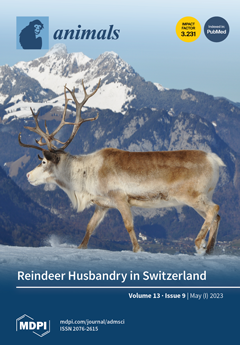Sexual dimorphism exists widely in animals, manifesting in different forms, such as body size, color, shape, unique characteristics, behavior, and sound. Of these, body mass dimorphism is the most obvious. Studies of evolutionary and ontogenetic development and adaptation mechanisms of animals’ sexual dimorphism
[...] Read more.
Sexual dimorphism exists widely in animals, manifesting in different forms, such as body size, color, shape, unique characteristics, behavior, and sound. Of these, body mass dimorphism is the most obvious. Studies of evolutionary and ontogenetic development and adaptation mechanisms of animals’ sexual dimorphism in body mass (SDBM), allow us to understand how environment, social group size, diet, and other external factors have driven the selection of sexual dimorphism. There are fewer reports of the ontogenetic development of sexual dimorphism in body mass in
Rhinopithecus. This study explores the ontogenetic development pattern of SDBM in wild black-and-white snub-nosed monkeys (
R. bieti), and the causes resulting in extreme sexual dimorphism compared to other colobines. A significant dimorphism with a ratio of 1.27 (
p < 0.001) appears when females enter the reproductive period around six years old, reaching a peak (1.85,
p < 0.001) when males become sexually mature. After the age of eight, the SDBM falls to 1.78, but is still significant (
p < 0.001). The results also indicate that males had a longer body mass growth period than females (8 years vs. 5 years); females in larger breeding units had a significantly higher SDBM than those in smaller ones (2.12 vs. 1.93,
p < 0.01). A comparative analysis with other colobines further clarifies that
Rhinopithecus and
Nasalis, which both have multilevel social organization, have the highest degree of SDBM among all colobines. The large SDBM in
R. bieti can be explained through Bergman’s and Rensch’s rules. Overall, environmental adaptation, a distinctive alimentary system, and a complex social structure contribute to
R. bieti having such a remarkable SDBM compared to other colobines. In addition, we found that females’ choice for males may not be significantly related to the development of SDBM.
Full article






